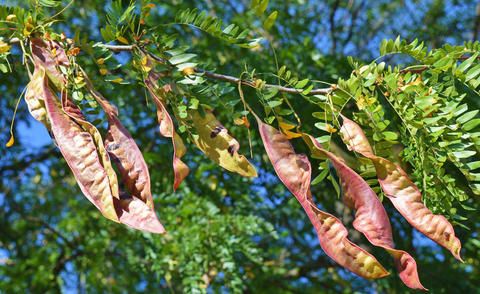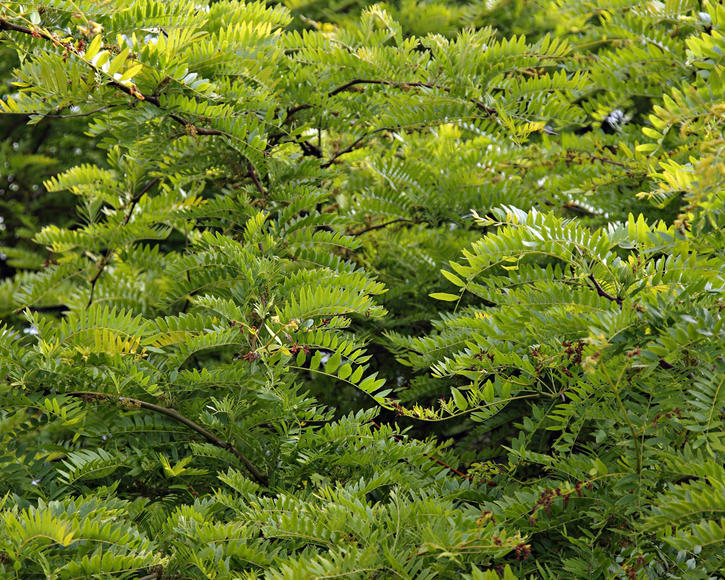Honey Locust
The Honey locust is characterized by delicate leaves, fragrant flowers and spectacular legumes. Here’s how to plant and care for the honey locust.
Factsheet
- Growth type
-
- Tree
- Growth height (from)
- from 1500 cm to 2000 cm
- Growth width (from)
- from 800 cm to 2000 cm
- Growth characteristics
-
- funnel-shaped
- umbrella-shaped
- thorns or spines
- Flower color
-
- green
- white
- Flowering time (month)
-
- June to July
- Flower shape
-
- Cluster
- Flower characteristics
-
- strongly fragrant
- dioecious
- hermaphroditic
- Leaf color
-
- green
- page format
-
- double feathered
- simply feathered
- elliptiques
- oblong
- lancéolées
- Sheet properties
-
- Autumn coloring
- Fruit color
-
- brown
- Fruit shape
-
- Sleeve
- Light
-
- sunny
- Soil type
-
- gravelly to loamy
- Soil Moisture
-
- fresh to humid
- ph value
-
- alkaline to weakly acidic
- Lime compatibility
-
- lime-tolerant
- Nutrient requirements
-
- nutrient-rich
- Decorative or utility value
-
- Fruit ornaments
- Leaf ornaments
- picturesque growth
- Toxicity
-
- non-toxic
- Winter Hardness
-
- conditionally hardy
- Climate zones according to USDA
-
- 6
- Use
-
- house tree
- Landscape woody plants
- Street greening
- Garden style
-
- natural garden
- Park area
- Bee Friendly
- bee friendly plant
The Honey locust (Gleditsia triacanthos), also known as the leather husk tree, is native to the central and western areas of America. The tree is most commonly found in mixed forests along river banks. After these plants were brought to Europe, Gleditsia triacanthos gained a foothold in many parts of southern Europe. On the other hand, you rarely see them in the wild in Central Europe.
The Honey locust from the legume family (Fabaceae) is fast to grow. In the first ten years it grows rapidly with sloping branches to a 49.21 to 95.61 feet-high funnel-shaped tree. Subsequently, their branches branch out horizontally on all sides, so that a picturesque umbrella-shaped crown opens over time. The zigzag shape of the branches is striking, the red-brown color of which changes over time to an olive brown. The attractive bark of Gleditsia triacanthos is gray-brown to black in color. It rips lengthways over the years and is made up of flat, peeling plates. The Honey locust has long thorns. Young twigs are densely covered with single thorns, branches and smaller trunks have branched tufts of thorns. Their size varies between 3.14 and 7.87 inches.
The deciduous leaves of Gleditsia triacanthos sprout relatively late from the end of May. They are alternately arranged on the branches with short stems and are single or double pinnate. The pinnate, fresh green leaves measure between 7.87 and 11.81 inches. They have 0.78 to 1.57 inches long leaflets, whose shape varies. Some are narrow and elongated, others look more elliptical. The simple leaflets have 20 to 30 alternately arranged leaves; the bipinnate leaves have eight to fourteen leaflets to the right and left of the petiole, each with 10 to 20 leaflets. The leaves of the Gleditschie briefly light up greenish-yellow at the end of October. They are mildly poisonous.

The rather inconspicuous 1.96 to 2.75 inches long, light green and white flower clusters of the leather pod tree open from June to July. They smell strongly of honey and attract many bees,butterflies, and other insects. There are male, female, and hermaphrodite flowers. Honey locust bloom for the first time after eight to ten years..
Its long, sickle-like and flat fruits have given the Gleditsia triacanthos its name honey locust. The leathery pods hang 7.87 to 15.74 inches long on the branches until deep into winter. They are often twisted in a spiral. As they ripen, their green color changes from red to dark brown. The seeds are edible. In North America, they are consumed as food, similar to lentils.
Honey locusts are sensitive to frost and wind, but can tolerate heat and drought. That's why they grow well in a sheltered, sunny place.
The Honey locust tree thrives optimally in fresh, moist soils that are permeable. Consequently, sandy-loamy or gravelly substrates are ideal. The pH value does not play a role for the well-being of Gleditsia triacanthos. It grows equally well on weakly acidic to strongly alkaline soils. On heavy and very nutrient-rich, moist soils, the honey locust is more susceptible to frost.

Honey locusts are sold in the tree nurseries as bales. It is advisable to plant them in spring or fall as mild temperatures and rainfall will encourage a good start. It is important that you insert a sturdy support post into the generously dimensioned planting hole before you plant the tree. Before insertion, the knot must be loosened from the cloth or cut open. Then you fill the excavated earth into the planting hole, compact the earth by stamping on it and fasten the support post to the trunk with a rope. The newly planted sapling must be watered thoroughly, otherwise the tiny honey locust will not grow well.
Young Honey locusts suffer in particular, if the soil is not moist enough. It should be watered regularly, especially in the years when it has a robust growth. Older specimens only need to be given water if the drought is prolonged. Otherwise, honey locust trees are extremely frugal beings. One dose of horn shavings horn shavings in spring is enough to take care of them.
The Honey locust is one of the few trees that respond well to pruning. A regular use of shears is only appropriate for trees that are drawn in the shape of a roof or umbrella in order to maintain their shape. Pruning is also recommended if branches obstruct each other, are too close together or if you want to visually support the bizarre growth of the honey locust. Gleditsia triacanthos must be pruned only in late summer! If pruned in spring, when the sap rises, it will bleed profusely, which in turn will make it very weak.
Heavy frosts can damage the Honey locusts. This is especially true for young trees. This can be remedied by a wire frame that is placed around the trunk and filled with leaves. With older trees it is sufficient to cover the ground with a thick layer of bark mulch.
Gleditsia triacanthos has made a name for itself as a city tree in Europe with its beautiful, light crown and its robust attitude towards exhaust fumes, road salt, frost, heat and hail. You can find honey locusts in many places on streets and in green spaces. However, landscape planners rely on varieties such as ‘Inermis’ or ‘Skyline’, which are similar to the species, but whose trunk and branches do not have thorns. The pale green foliage, resembling ferns, makes honey locusts look delicate despite its size. Varieties that remain smaller than the species and are thornless are suitable for gardens. With good exposure to light and the deeply growing roots, they can be planted as a ground cover.

Thornless varieties of the honey locust are available for every garden size. Gleditsia triacanthos ‘Elegantissima’ is a large multi-stemmed shrub or small tree with a trunk. The variety reaches a height of 13.12 to 22.96 feet, has dark green, very finely pinnate leaves and is thornless (if it is grafted on Gleditsia triacanthos f. Inermis). Honey locust ‘Sunburst’ is a small tree, occasionally just a large shrub, 22.96 to 39.37 feet high. The leaves appear golden yellow, later yellow-green. The variety does not develop pods or thorns.
Since the seeds in the pods are mostly sterile, it is recommended not to propagate the honey locust,by self-sowing . The varieties are grafted in special tree nurseries.
Honey locust belong to the trees that are hardly affected by plant diseases and are also uninteresting for pests.

